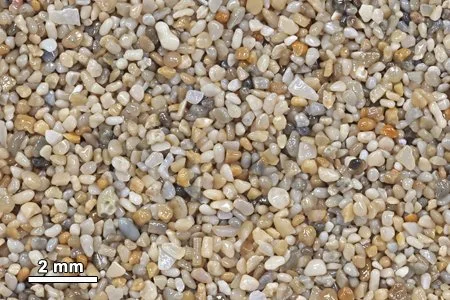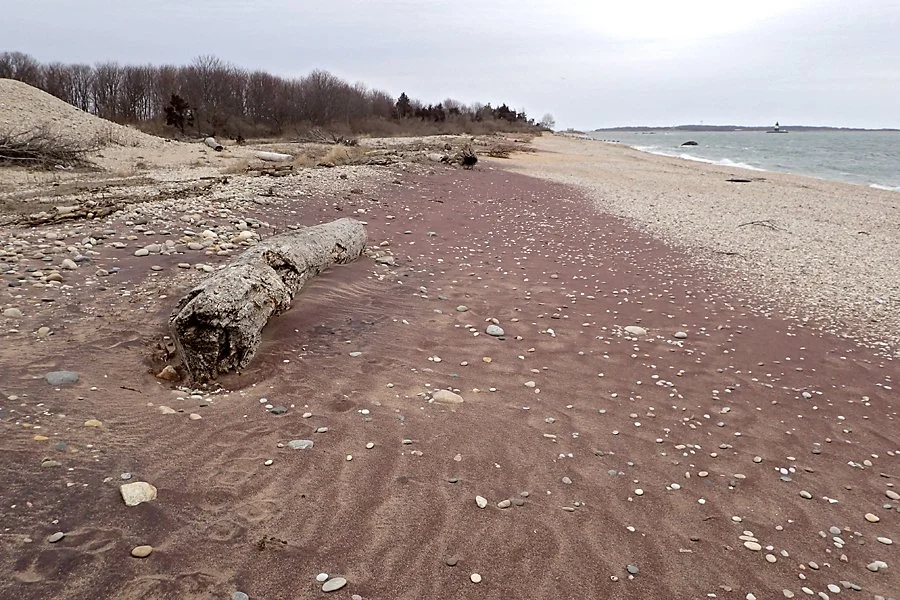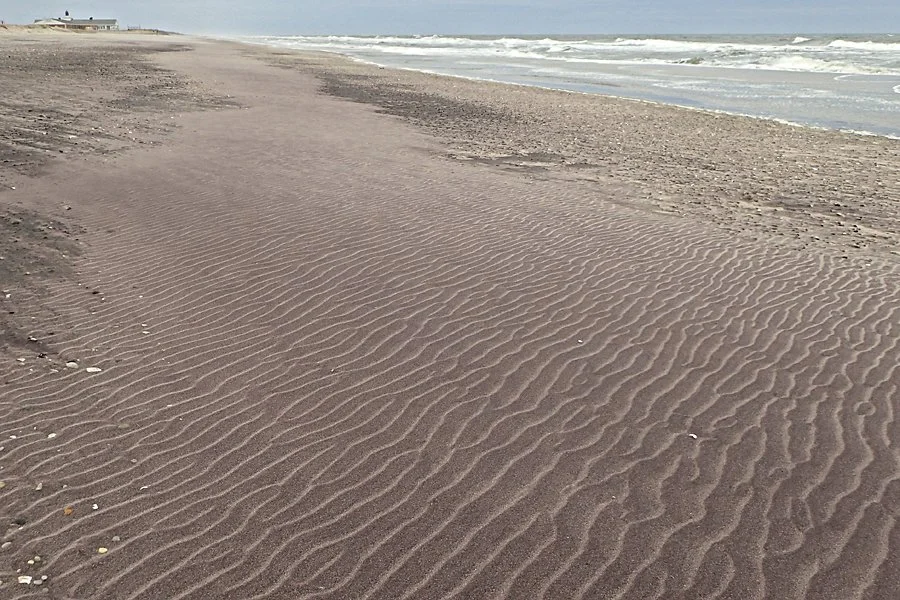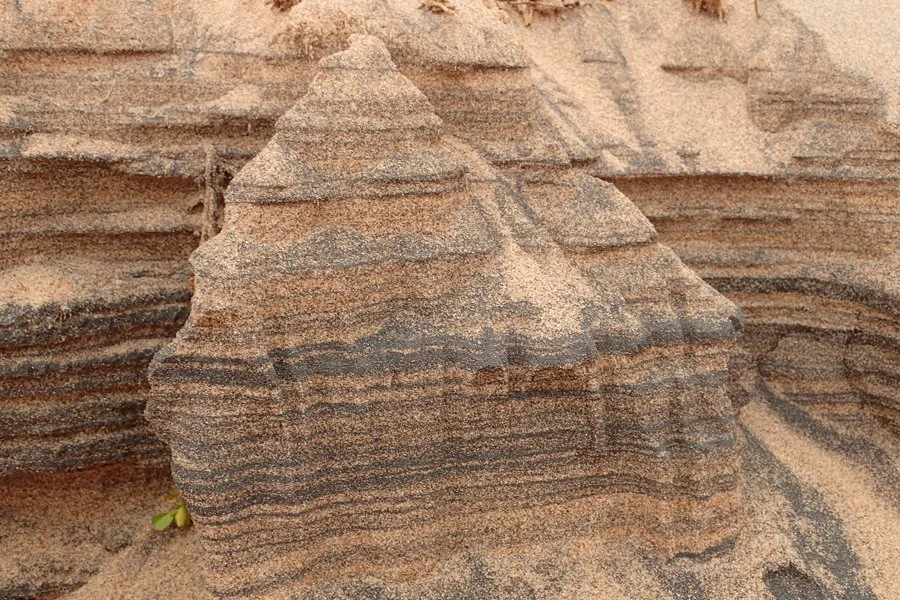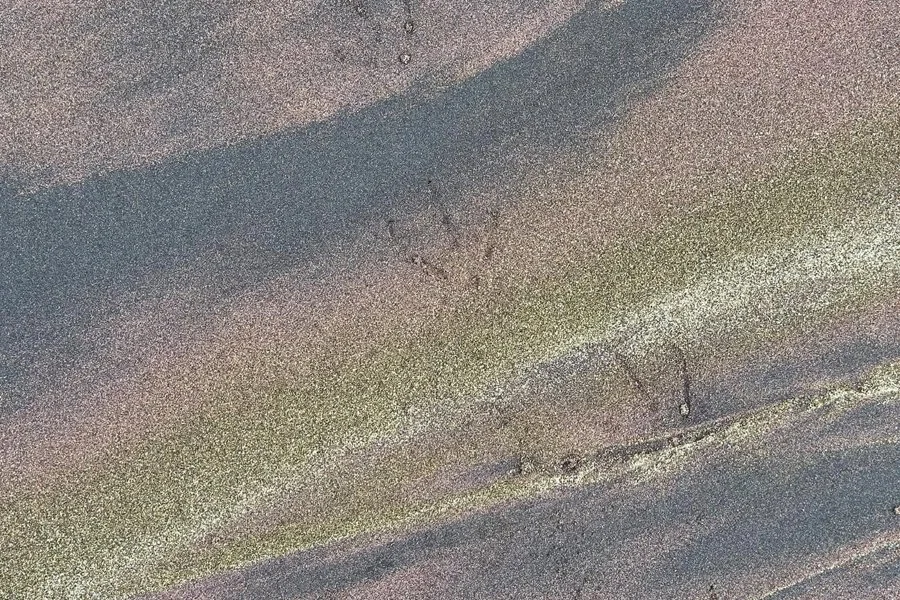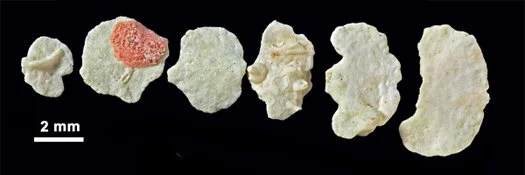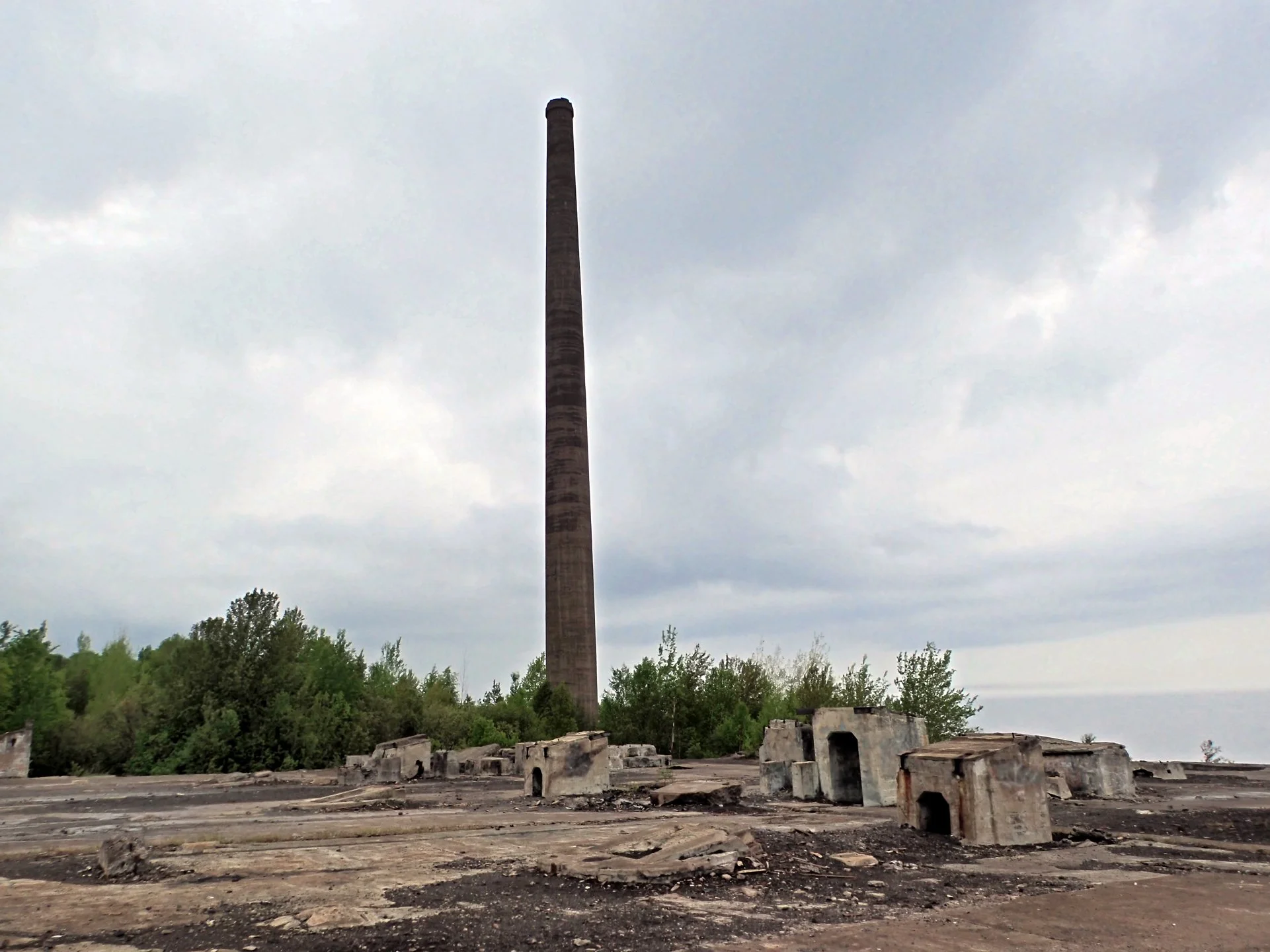
What is Sand?
Rock Harbor, Isle Royale, Lake Superior, Michigan, USA | Photo by Leo Kenney
Sand Might Be More Than You Think
HOME / SCIENCE / WHAT IS SAND?
When was the last time you walked on the beach or climbed a sand dune? Did you come home with sand in your shoes, in your pockets and in your car? While there, did you notice the color and texture of the sand? Was it different from the beach where you spent your winter or summer vacation? Have you ever wondered why sands are different from one location to another?
Some of us intentionally bring sands home. We get a kick out of collecting from different locations, looking at sands under the microscope, and identifying the mineral grains and the hard remains of shells, sea urchins and corals. Some of us like photographing our samples to better appreciate the beauty and character of the grains.
The photographs here showcase sands under magnification.
Naniboujou Lodge Beach, Lake Superior, Grand Marais, Minnesota
Sand Characteristics
A sand sample can be described in terms of grain size, color, composition, morphology (angularity and shape), and surface texture. Grain size is a result of several factors, including composition, durability, severity of weathering conditions, transport distance from its site of origin, and physical sorting by wind and/or water currents.
Left to right
Row 1: 1. Marquette Park Beach, Lake Michigan, Gary, IN, USA; 2. Navakshott, Trarza Region, Mauritania; 3. Ocean Cay, Bimini Island, Bahamas; 4. Foreman Arch, Devils Backbone, OR, USA;
Row 2: 1. Shipwreck Beach, Zakynthos Island, Greece; 2. Mackenzie River, Northwest Territories, Canada; 3. Kaihalulu Beach, Hana, Maui, HI, USA; 4. Flagler Beach, FL, USA;
Row 3: 1. Broad Cove, Cape Breton, Nova Scotia, Canada; 2. Isla Verde Beach, Calle Gardenia, Carolina, Puerto Rico; 3. Cedar Creek Reservoir, AL, USA; 4. Green Sands Bay, Hawaii, HI, USA;
Row 4: 1. Vatnajökull National Park, Iceland; 2. Khongoryn Els Singing Dunes, Gobi Desert, Mongolia; 3. Taketomi Island, Okinawa, Japan; 4. White Sands, Tularosa Valley, NM, USA
Sand
Sand is a specific size of loose grains of minerals, rocks, and organic remains.
"Sand" forms in different ways. The vast amount of sand forms when pre-existing rocks break down by weathering and erosion. The breakdown produces two products: mineral grains and rock (lithic) fragments.
Sand can also be formed from the skeletal remains of marine organisms, such as shells and chunks of coral. These are biogenic sands. These include modern sands found along oceans shores today and fossil sands from ancient seas.
Other grains are formed by chemical reactions. Oolites, for example, are grains that roll and form in a shallow carbonate-rich environment. Glauconite also forms in shallow marine environments.
Other grains are fragments of manmade products from our lives and industry: glass, ceramics, plastic, slag, or bricks. These are called anthropogenic grains. Sometimes micro-meteorites rain from the sky; these are extraterrestrial in origin.
Understanding a Scale Bar
Notice the 2mm scale bars on the images. The three photos below show the same sand, but they are magnified to three different levels. Higher magnification allows us to see more details on the grains. In this example, notice that the same number of grains fit on each of the 2mm scale bars. (Ptolemais Beach, Al Fatih, Libya)
Grain Size
Many sand collectors don't care about "grain size," but to geologists, "sand" – by definition– is a grain size and technically between 0.063 to 2 mm.
"Sand" is further divided into coarse, medium and fine "sand." Grains coarser than sand are pebbles, cobbles and boulders; grains finer are silt and clay.
Very coarse sand grains are between 1 to 2mm in diameter, the size of peppercorns. (Restricted Diamond Area, Namibia)
Medium sand grains are between .25 to 0.5 mm in diameter, the size of granulated sugar. (St. Peter Sandstone, Buffalo Rock State Park, Illinois)
Coarse sand grains are between 0.5 to 1 mm in diameter, the size of coarse sugar. (Peschanoye Lake, Kunashir Island, Kuril Islands, Sakhalin Oblast, Russia)
Fine sand grains are between .063 and .25 mm in diameter, the size of superfine sugar. (Point Cormorant, Floreana Island, Galapagos Islands, Ecuador)
Grain Roundness
The roundness of sand grains provides clues to their history of transport from their original source. During sediment transport, grains will repeatedly come into contact with other grains, and the sharp edges will chip off. Progressive rounding and smoothing occurs with continued transport and agitation.
Transport and rounding occurs in rivers, by waves and currents along a coastline, or by wind in the desert. The Ice Age glaciers were also responsible for transporting tons of material from their original source locations.
These angular grains of clear quartz and pink to orange feldspar eroded from nearby granite bedrock. The angularity of the grains indicates they have not traveled far from their source. (Masai Mara National Reserve, Kenya)
Rounded and polished grains are found on high-energy shorelines where the winds, waves and currents keep the grains in near constant motion. (Black Sands Beach, Sausalito, California, USA.)
Sands found in deserts are rounded and frosted from wind abrasion. These grains show iron staining. (Syrian Desert, Jabal Qasiyun area, Syria)
The angular edges of biogenic grains – sea urchins spines, shells and other marine organism – become smoother as they roll in the surf. (Playa La Posita, Puerto Rico.)
Sorting
"Sorting" describes the distribution of grain sizes within a sample. A well-sorted sample is composed of grains mostly all one grain size. A poorly-sorted sample contains a wide variety of grain sizes. This well or poorly sorted classification reflects the origin and transport history of the grains. With increased transport distance, the different grain sizes tend to separate out.
This sample has a bimodal grain distribution. The tiny grains are all the same size, and the coarse grains are all the same size. This reflects two distinct sources for these grains.
(Cala Dels Pinets, Vinaros, Spain)
This sample shows a variety of grain sizes.
(Caribou Creek, Dempster Highway, Inuvik, Northwest Territory, Canada)
Dune sands are considered well-sorted. That's because the wind only blows medium-sized grains. Coarser grains are too large to blow. As the wind blows the grains, they bounce along the ground and become airborne creating dunes. Dune sand grains are rounded and frosted because of continuous collisions with other grains.
(Great Sand Dunes, Colorado)
Grains in this sample range from coarse to fine.
(Attu Island, Alaska)
Composition
What are the grains in sand? It really depends on the location. An ocean beach along a rocky coastline will contain sand grains of the same rock. If you are on a tropical island, the beach sand will contain shells and bits of other marine organisms. If you are one of the Great Lakes beaches, the sand likely contains quartz. Read further. We'll introduce some components found in sand.
Sand Composed of Rock
This sample contains a mix of fragments of mica schist, a metamorphic rock, found along the Maine coastline plus fragments of blue mussel shells, creamy colored barnacle plates and sea urchin spines.
(Two Lights State Park, Cape Elizabeth, Maine, USA)
This sample, from a fjord on the south coast of Greenland, contains angular grains of the local bedrock: garnet-quartz-gneiss and granodiorite. By definition, "rocks are an aggregate of minerals" and within some of these coarse grains, distinct minerals can be seen. For example, see the black augite rods in the clear quartz. These are angular grains and have not traveled far from their original source.
(Fjord-Tasilaq, Greenland)
Over the ages, lightning has ignited coal seams, and the heat from the burning coal has caused area rocks (and sand grains too) to be cooked, fused and melted. This intense heat transforms rocks like sandstone into brick-like rock, and shale into ceramic-like rock. Other rocks melt and look like hardened lava or glassy obsidian.
This sample was collected at an anthill. Ants are great excavators and only transport the particular grain size they can carry.
(Ant Sand, Yellowstone River, Terry, Montana, USA)
This sample contains grains of black basalt, a common igneous rock found in regions with a volcanic history. Mixed with the basalt are fragments of blue mussels and caramel colored barnacle plates. This beach is known as the "Yellow Sand Beach."
(Skarðsvík Beach, Iceland)
Sand Composed of Minerals
Sands are formed from the weathering or breakdown of other rocks into rock and mineral grains. The hardest mineral grains survive the weathering and are most commonly found in sands. We'll discuss the most common minerals.
Quartz
Quartz is the MOST common mineral found in sand and sandstone and a major constituent of granite and metamorphic rocks such as gneiss. As these rocks break down, the quartz grains survive over long distances and eons of time because quartz is hard and chemically stable.
Quartz grains can break and abrade during transport, but with a hardness of 7 on the Mohs' scale of hardness, the grains become rounder and rounder over time. They can be clear or cloudy; some quartz grains show reddish iron staining.
(Duck Harbor, Wellfleet, Massachusetts, USA)
Mica
Mica flakes are platy in shape and may be found in sands where the local bedrock contains decomposed granite or metamorphic rocks. There are many varieties of mica. The most common is white mica (muscovite) and brown mica (biotite).
(Plum Island, Ipswich, MA, USA)
Feldspar
Most igneous rocks, including granites, contain feldspar as a major component and hence, feldspar grains are commonly found in sands. Feldspar grains are moderately elongated, and grains show near 90° corners.
Feldspar is technically a mineral group with varying amounts of calcium, potassium and sodium. With variations in chemistry, the grain color can be clear to cloudy, pinking, orangish, or yellowish.
(Pikes Peak, Colorado, USA)
Olivine
Olivine is a pale olive green to yellow-green mineral with a translucent luster that is commonly found in sands from volcanic regions.
Olivine is a mineral series with varying amounts of iron and magnesium in the crystal structure. That means, that as the chemistry changes, the color shifts. Forsterite is olive-green to yellow-green in color and magnesium rich. Fayalite is brownish-gray in color and iron-rich. These are the most common members.
(Green Sand Bay, Hawaii)
Heavy Mineral Sands
This sample includes pink garnet, blue sapphires, opaque magnetite, green clinopyroxene, and yellowish monazite.
(Plage De La Paree, Bretignolles-sur-Mer, Vendee, France)
Deep pink garnet sand. (Lake Baikal)
(Lake Baikal, Russia)
Coarser grains of quartz and feldspar are mixed with magnetite and ilmenite.
(Lake Superior, Madeline Island, Wisconsin)
Winter waves concentrate green epidote and opaque chromite on the south Oregon coast.
(Devils Backbone, Oregon, USA)
Some minerals found in sand are considered heavy minerals. That's because they are heavier – or technically "denser" – than quartz. Because of the differences in mineral densities, the grains behave differently in the wind and waves. Heavier grains, garnet or magnetite, for example, tend to stay in place while the less dense minerals, quartz for example, blow or wash away. This grain separation creates colorful patterns and swaths on the beach.
Common heavy minerals include pink to red garnets, and opaque magnetite and ilmenite (iron minerals). Other heavy minerals include green epidote, blue sapphires, clear zircons and gold. Heavy mineral sands may look "dirty" on the beach; however, under the microscope they are some of the most beautiful sands especially if they include garnets.
Heavy mineral sand on beaches
The thickest heavy mineral deposits form high on the beach during storms when storm waves run up the beach with great energy and deposit the heavy minerals. Lighter minerals, such as quartz, will wash back into the water.
(Orient Point, Long Island, NY. USA)
As the tide ebbs, heavy minerals, magnetite and garnet, concentrate in the troughs of the tidal ripples.
(Fire Island, Long Island, NY. USA)
An eroding beach face illustrates layers of quartz and heavy minerals (magnetite and ilmenite) concentrated by the sorting action of storm waves.
(Lake Superior, Madeline Island, Wisconsin. USA | Kate Clover photo.)
Heavy minerals in sand
Garnets are hard minerals and survive weathering and transport. In crystal form, they are 12-sided (dodecahedrons) and are often seen as rounded grains in sands. Garnets are a group of minerals and their color depends on their chemistry, most range from deep red to orange to pale pink. They are considered heavy minerals and are often found together with magnetite and ilmenite.
Magnetite and ilmenite are common opaque iron minerals found in sands. These grains are black and are typically smaller than quartz. Magnetite is magnetic. Ilmenite is non- magnetic. To test, put a magnet on the outside of your sample bag or bottle. Chromite, another opaque mineral is less common, also non-magnetic.
Patterns of pink garnet, black magnetite and green epidote appear on the beach as the tide ebbs.
(Lighthouse Beach, Coos Bay, Oregon. USA | Steven Michael photo)
Biogenic Sands
Biogenic sands are a another category. These are also known as "carbonate sands" as they are composed of the hard skeletal fragments of marine organisms whose body structures are made of calcium carbonate (either calcite or aragonite).
Biogenic sands are composed of whole or broken fragments of marine organisms: corals, shells (bivalves and gastropods), sea urchins, barnacles, and many others creatures. Also, some algae calcify, and their lobes contribute to sands. The grains in a biogenic sample vary from location to location and reflect the marine ecosystem and the marine organisms in that particular location. When viewed under magnification, biogenic samples are among the most interesting of sand grains.
To test for carbonates in a sand: Put a couple drops of white vinegar or other mild acid on a small amount of sand; if the sample bubbles and fizzes, that confirms it contains grains made from calcium carbonate. Rocky sands will not react with the acid.
The rocky coastline near Charleston/ Coos Bay, Oregon supports a diversity of marine life. Seen here are caramel-colored barnacle plates, a crescent-shaped chiton plate, sea urchin spines and body fragments, snails, forams, a branch of coralline alga and more.
(Qochyax Island Land Bridge, Coos Bay, Oregon, USA)
Mollusks
The seashells found washed up at the beach are mollusks, a large group of organisms that have calcareous hard parts. Mollusk shells are made of calcium carbonate and vary greatly in shape and size from micro-mollusck to giant clams. The shell content on beaches is highly variable, and the eroded fragments of mollusks are common in sand. There are many thousands of mollusk species and thousands more from the fossil record. We will highlight the common ones.
Bivalves include clams, scallops and mussels. Bivalves have two shells.
Fragmented mollusk shells are common components of sand. The species and abundance vary with the environment.
(Playa Avante, Monteagudo Island, Galicia, Spain)
Gastropods include snails. Their carbonate shell can be coiled, conical or cap-shaped. Common gastropods include conchs, whelks, cones, cowries, and many more.
Mollusks living on the reefs in the Florida Keys include spired and ribbed snails and tapered tusk shells. Also in this sample are volcano-like barnacles and stalks of segmented coralline algae.
(Tea Table Key, Florida Keys, Florida, USA)
Sometimes one species of tiny snails dominates a sample.
(Harlingen Beach, Harlingen, Friesland, Netherlands)
Chitons make up a small group of marine mollusks. They are flattened and usually elongated and are protected by a shell that consists of eight dorsal plates. Their crescent-shaped plates are sometimes found in sands. Most live in rocky intertidal zones.
The offshore reef on Puerto Rico's north coast supports an array of marine organisms. These wave-washed and polished grains include a couple varieties of sea urchin spines (bumpy and ridged), a crescent-shaped chiton plate, polished rods of coralline algae, forams, snails, and forams. The lumpy tan-colored chunks are well-worn pieces of carbonate rock, the base of the reef.
(Playa La Posita de Pinones, Loiza, Puerto Rico)
These fragments of blue mussels and crab shells were excreted by a gull that had been feeding at the shore. Predators, wave action and the pounding surf all break up the hard body parts of marine organisms.
(Plum Island, Massachusetts, USA)
This sample illustrates the erosion of gastropods. Some are whole, others are partially eroded. The chalky branched segments are coralline algae.
(Playa Los Pozos, Puerto del Rosario, Fuerteventura, Canary Islands, Spain)
The hard shells of gastropods erode as they roll in the waves and surf. The outer parts of the shell are the first to erode. The spiraled, central columns are the hardest and most resistant to erosion; they are often found in sands.
(Venetian Lagoon, Venice, Italy)
Chiton plates are arched and crescent shaped. Their six plates vary a little in size.
(Qochyax Island Land Bridge, Coos Bay, Oregon)
Echinoderms
This interior view of a sea urchin test (its skeleton) shows the rows of plates with their radial pattern of pores. These plates are the fragments with pores found in sands; their reverse side shows the bumpy tubercles (see the Pembroke, Maine photo).
(unknown source for urchin test.)
Sea urchins and sand dollars are echinoderms — the spiny-skinned animals of the sea. They are characterized as having radial symmetry and usually five-part (pentagonal) symmetry. They also have spines used for moving, feeding, and protection. The spines of sea urchins are rigid and robust and often found in sands; sand dollar spines are tiny and delicate and don't survive a lot of heavy wave action.
As sea urchin spines roll in the surf, their surface texture smooths. In cross-section, an urchin spine resembles a mandala.
(Dive Club Beach, Ascension Island.)
Fragments of sea urchins are commonly found in marine sands. There are many varieties and their spines vary, from thin and sharp to thick and blunt. Some spines show elongated ridges, others are bumpy. The fragment of an urchin body (or test) seen in this photo shows the bumps (or tubercles) where the spines attach.
(Leighton Point Beach, Pembroke, Maine, USA)
Sand dollars are echinoderms, and like sea urchins, they have spines. The spines on sand dollars are super tiny, and they form a coating that feels like felt. These spines are the "feet" that sand dollars use to move around and burrow in the sand.
(Heceta Head Beach, Florence, Oregon. USA)
Foraminifera
Foraminifera (forams) are single cell protists found in all marine environments. They may be particularly abundant in some areas. Forams compose much of the sand on this beach.
(Diakofti Beach, Diakofti Island, Greece)
Sand from Japan includes star-shaped and globular forams. After the spiny forams die, their spines gradually blunt and abrade as they roll in the surf.
(Star Sand Beach, Okinawa, Japan)
Forams from Guam in the South Pacific illustrate a variety of forms, including spiny and globular, flat discs and the red encrusting foram, Homotrema rubra.
(Various beaches, Guam)
Forams from Papua New Guinea include spiny globular forms, flat discs and a variety of other forms.
(Various islands, Papua New Guinea)
There are estimated to be over 40,000 foraminifera (forams) species worldwide (both modern and in the fossil record). Some are planktonic, drifting in the ocean currents; other are found in the sediment on the ocean bottom. Other are encrusters and attach to rocks, corals, shells and other materials. Forams have specific habitats with varying requirements for water depth, salinity, and temperature. The species vary by location. Most are the size of a small pin-head. Their intricate shells show a great diversity in shapes and structures from spheres, coiled, tubular, flat, star-like, and chambered.
Barnacle shells are composed of variously shaped plates.
(Qochyax Island, Coos Bay, Oregon, USA).
Barnacles are common in oceans worldwide. There are many varieties; some prefer cold water, others warm water. Barnacles are considered "encrusters." Some attach to rocks and piers, others to floating debris in the ocean (like flipflops), others to whales and turtles. Their carbonate bodies are made up of numerous plates; typically, they have 6 base plates and 4 operculum plates (that's the "trap door" opening at the top). The base plates typically show channels. The operculum plates are more triangular in shape. After the barnacles dies, the operculum plates are the first to disarticulate leaving the "volcano-like" shell still attached.
Barnacles
This sample contains barnacle plates as well as sea urchin spines and blue mussel shell fragments.
(Eggemoggin Reach, Brownville, Maine, USA)
The sand at Cathedral Cove on New Zealand's NE coast is soft pink in color. The color comes from a species of pink barnacle, Notomegabalanus decorus, only found in waters around New Zealand. Also in the sample are gastropods and grains of quartz.
(Cathedral Cove, Mercury Bay, Hahei, New Zealand)
Northern acorn barnacles (Semibalanus balanoides) are common barnacle in the intertidal zone of cold to sub-polar coastal waters in the Northern Hemisphere. They thrives on rocky shore habitats. The barnacles looking like volcanoes are dead; those with the closed operculum ("trap door" opening) are alive. When the tide rises and the barnacles are underwater, their operculua open, and they filter food from the seawater. When the tide falls, the operculua again close to prevent desiccation.
(Dead Horse Beach, Salem, Massachusetts, USA)
Dead Halimeda. strands found on a Florida beach.
(Hollywood Beach, Florida, USA)
Seen here are branches of three or four different red coralline algae. Notice the structural and textural features on these specimens and their branching patterns. Fronds can be delicate with branching off of each segment or stacked with segments as wide as they are tall. Some lobes are wingnut shaped and fit snugly together. The raised white bumps on the middle segment are conceptacles, these house reproductive structures.
(Otter Rock Marine Reserves, Oregon, USA)
Maerl segments are chalky white.
(Austvågøya Island, Lofoten Archipelago, Norland, Norway)
This highly polished sample from Puerto Rico's northeastern shore sees constant wave action. The branched fragment in the center and the caramel colored rods are coralline algae. Urchin spines look like jelly beans. Also in this sample are forams and gastropods.
(Playa La Posita Piñones, Loíza, Puerto Rico)
The green alga Halimeda grows as branching colonies with individual segments. Where this seaweed grows, the segments wash onto beaches and contribute to the carbonate sediments.
(Coxen Cove, Roatan Island, Honduras).
Carbonate-forming Plants
The plant kingdom is a major contributor to beach sands primarily in the form of calcareous algae. We’ll mention the common ones.
Green Algae
The green alga Halimeda grows as branching colonies with individual segments. When the plant dies, the segments may wash onto beaches.
Coralline algae are red algae. Some red algae form segmented branching structures, others encrust surfaces. Alive, these are pink to purple-red in color. Dead fragments can be shiny or bleached to white. Their segments show no pores.
This rocky coastline on the Pacific Ocean is known for its biodiversity. Seen here are blue mussel shells, two or three different coralline algae, sea urchin spines, lacy bryozoan, barnacle plates, and chunks of basalt rock.
(Otter Rock Marine Reserves, Oregon, USA)
The coralline algae found in waters around Norway is pink and forms coral-like reefs. It is known as maerl and deposits calcium carbonate in its cell walls as it grows. The dead, branched segments, crushed by the waves and bleached by the sun create chalky white beaches.
(Austvågøya Island, Lofoten Archipelago, Norland, Norway)
The smooth and shiny branched segment in this sample is coralline algae. The red chunks are fragments of the red encrusting foram, Homotrema that impart a pink hue to some Bermuda sands. The ridged blue rod is a fragment of a sea urchin spine. Also find small forams and gastropods in this sample.
(Horseshoe Bay Beach, Southampton, Bermuda)
Halimeda is a green alga, a common seaweed flora found in shallow tropical waters. The green alga calcifies by precipitating calcium carbonate within its segments. Seen here is a partially calcified alga body (some green, some white). Halimeda is the dominant "sand" grain on some tropical beaches; these "sands" are called "oatmeal sands."
(Andros Island, Bahamas)
Segments of the calcified green macroalgae Halimedia look like oatmeal flakes in sand samples.
(Garden Key, Dry Tortugas, Florida, USA)
Red Algae
Fossil Sand
Fossil sands are also considered biogenic sands as they contain the fossilized remains of shells and the skeletons of marine organisms that lived in ancient oceans.
Fossil shark teeth are found in New Mexico. where the Western Interior Seaway (Cretaceous Seaway) used to flow. This seaway stretched from the Rockies east to the Appalachian Mountains, and reached from the Arctic Ocean to the Gulf of Mexico. The sea existed for 34 million years from about 100 million years ago to 66 million years ago.
(Shark Tooth Ridge, New Mexico, USA)
This sample includes grains eroded off the bluff coast on Lake Michigan, north of Chicago. The bluffs are the terminal end of a glacial moraine and contain quartz and other minerals carried by the glaciers. The sample also includes fossils transported by the glaciers – crinoid rings and bryozoans (the grains with pores). These fossils are evidence of the marine life in the warm shallow sea that covered the region ~420 million years ago.
(Lake Michigan. Tower Beach, Winnetka, Illinois. USA)
Between about 56 to 33.9 million years ago, a warm tropical sea covered much of what is now north-central France. The marine basin, the Paris Basin, is famous for its shell sands. Scientists have recorded over 1100 species from this site: gastropods, bivalves, forams, coral and more.
(Bois-Gouët, France)
This fossil sample includes lacy and rod-shaped bryozoans, crinoid rings and columns plus a shark tooth.
(Cedar Creek Reservoir, Alabama, USA)
Other Non-biogenic Carbonate Grains
Ooids (sometimes called oolites) are hard, orb shaped grains that are inorganic is origin. Oolites look polished and resemble fish roe. Ooids form when thin, concentric layers of calcium carbonate form around a nucleus, such as a tiny shell fragment or a bit of fecal matter. They form in shallow, supersaturated carbonate environments. They are pretty rare: they are found in Great Salt Lake, Utah, in the Bahamas, the Persian Gulf and Red Sea plus a few other places. They are also found in the fossil record, i.e. oolitic limestone..
Oolitic Sand
(Antelope Island, Great Salt Lake, Utah, USA)
Glauconite Sand
Glauconite is a distinctive patchy green mineral. Grains are irregular in shape. They form in shallow marine environments where minerals are altered by seawater.
(Conecuh River, Andalusia, Alabama, USA)
Gypsum Sand
Gypsum is an evaporative mineral (calcium sulfate) that forms the dunes at White Sands National Park in New Mexico. Over millions of years, rising and falling sea levels left behind gypsum on the sea floor. As the climate became hotter and drier, the lake evaporated leaving the gypsum. Wind blew the smaller "grains" to create the dune.
(White Sands, Tularosa Valley, New Mexico, USA)
(Playa Mar de Cristal, Islas Menores, Murcia, Spain)
Anthropogenic Sands and Anthropogenic Grains in Sands
Anthropogenic sand is "sand" generated by human activity. Consider the "Stamp Sand" beaches around the old copper mining district in northern Michigan. The beaches look natural, but they are made almost entirely of the waste rock that was dumped into the lake at the copper mining and milling operations decades ago. Over the years, the waves and currents have rounded the grains, and the grains looks like natural sand. Another "beach" in Silver Bay, Minnesota is 100% taconite "sand" from the iron mill that used to operate there. These beaches are legacies of the mining industries, there is no "cleaning them up."
Anthropogenic grains include fragments of bricks, slag, coal and cinders, glass and pottery, plastic, aluminum blobs, reflective glass beads, paint chips and other products. These "grains" are a legacy of our industrial history.
Decades ago, before Kauai got a landfill, lots of trash was dumped over the cliffside into the ocean. That included lots of glass originating from broken bottles and auto glass. Today the shoreline at Glass Beach is covered with millions of pieces of sea glass - brown, aqua-colored, clear and blue.
(Ele‘ele, Kauai, Hawaii, USA)
This sand looks natural, but the grains are the crushed waste rock, "stamp sand" from the Champion Stamp Mill in Freda that processed copper ore decades ago. (This was one of many stamp mills in the copper mining region.) The mills were located along the shoreline, and the waste rock was dumped into Lake Superior. Over the years, the waves and currents have rounded the grains and transported the stamp sands miles and miles up and down the shoreline.
(Lake Superior, Stanton Township Park, Houghton, Michigan)
Collected from the Mississippi River in Minneapolis, the anthropogenic grains here reflect an industrial city along the river: fragments of black coal, porous cinders, blue-black slag, red bricks and a sand blast "shot." The rocks and minerals grains include quartz, feldspar, and basalt.
(Mississippi River Dredgings, Interstate 35 W, Minneapolis, Minnesota, USA)
The gray-green sand beach at Nonza on the island of Corsica in the Mediterranean Sea looks pretty. But it is an anthropogenic sand, and is entirely made of waste rock from a serpentine asbestos mine that operated from the late 1930s through 1965. The waste rock contains asbestos minerals which have a high fibrous structure known to be carcinogenic. The rock was dumped in the Sea before people really knew the health hazards of asbestos. Historically, asbestos was used as a fire retardant and insulating material.
(Nonza Beach, Corsica, France)
This sample includes orange-red brick fragments, artifacts of Haverstraw's history as the "brick making capital of the world." Billions of bricks were made and shipped 40 miles down the Hudson River to New York City.
(Hudson River, Haverstraw, New York, USA).
Plastic pollution is a global problem. This sample collected from a beach near Fort Lauderdale includes fibers from fishing line and rope as well as fragments of plastic objects and foam flotation material. Near the center are microplastic beads.
(Mizell-Johnson State Park, Florida, USA)
IIn 1876, the wild west town of Deadwood, South Dakota was born when prospectors came across a gulch full of dead trees and a creek full of gold. In short time, a gold rush ensued. Miners initially panned for gold in the streams, then underground mining began. The deposit was mined over a span of 126 years, closing in 2002 and producing over 40 million ounces of gold. This sample is waste rock from early mining days. Later, waste rock was used to fill underground stopes. The yellow and white chips are road paint.
(Deadwood Creek, Deadwood, South Dakota, USA)
Ruins of the Champion Stamp Mill on the shore of Lake Superior, near Houghton, Michigan, still stand today. The mill operated from 1891 - 1913 and was built to crush copper ore. The crushed waste rock, called "stamp sand," was all dumped into Lake Superior. The copper concentrate was sent to the smelters, melted and poured into ingots.
(Lake Superior, Houghton County, Freda, Michigan)
The blue fragments, ranging in color from clear Robin's Egg blue to greenish and purplish, are industrial slag, a bi-product from smelting iron in the early-to-middle 1800s. Slag is glassy looking and brittle and often pitted with air bubbles created when the molten slag was cooling.
(Wells Creek Basin, Tennessee, USA)

